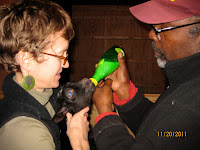"The child becomes a person through work." --Maria Montessori, physician and educator
A few weeks ago, my twin sister and her daughter came to spend a weekend with us. For my girls, having their Auntie Jules come to visit is a little like getting a trip to the amusement park without having to leave home. She is one of those rare adults who actually remembers what it was like to be a kid. She tells goofy jokes; she tickles; she teases; she plays hide and seek; she gets everyone (including herself) in trouble with the other adults; and--most incredibly to me--she seems to thoroughly enjoy all of it. For her, hanging out with kids is not exhausting but invigorating. And they know it. They LOVE it.
Jules is also pretty good with hammers, drills, screwdrivers, and power saws. My academic husband and I are--well, let's just say we are not. (He may beg to differ, as he often insists that he is actually quite skilled with all such tools. I'm remaining skeptical until I see him actually do something with them.) When Jules comes to visit, then, she tends to get strapped into putting things together, hanging things on walls, and fixing things we have broken. Among the tasks I had lined up for her that weekend was helping me hang some heavy tool racks in the garden shed and the barn. It was a surprisingly time-consuming job and one that took us the better part of an afternoon. But we got finally got them up straight and secure. And it felt great.
While we were working, the three girls (her 4-year-old and my 5- and 7-year-olds) came to ask Jules if she could help them build a secret hideout out of some of the planks and boards left over from the barn construction. My girls had been "building" things with these pieces for a couple of weeks--cobbling together houses, a playground, paddocks, and so forth. But now that they had seen us at work, they wanted to do some real building--the kind with hammers, screwdrivers, and saws. So of course, Jules followed them down to their work site in the pasture and stayed there for more than an hour helping them to put together their hideout. I have rarely seen such serious, concentrated labor. They hammered, measured, screwed, sawed, checked the level, made adjustments, and then stood back to admire their work. They were elated.
Later, after their aunt and cousin had gone back home, I asked the girls, "What was your favorite part of the weekend?" You can probably guess their answer. Even though they had played endless games, marched in a parade, seen a video, put on a super-silly play, been read to numerous times, and been taken to get ice cream--with sprinkles--they immediately responded that their favorite part of the weekend was building the hideout with Auntie Jules.
Why is this? Because kids love to do real work. Not all the time, of course (as any parent who has begged his child AGAIN to clean up her bedroom will attest). But in general, kids get a great deal of satisfaction out of doing meaningful labor. Unfortunately, this is one of those things that most of us adults have forgotten about childhood. We assume that kids want to play. And to some extent we are right: they do want to play. They need to play and ought to play. But for kids, doing real work can be the best kind of play. My girls, for example, enjoy playing chef. So occasionally I let them drag my mixing bowls, measuring cups and spoons, and cutting boards out of the kitchen cabinets and set up a pretend kitchen in the den. They pour, stir and chat, chat, chat as they concoct elaborate dishes for their dad and me to "taste". This is fun. Yet most days both of them would choose instead to help me mix up a real cookie batter, or chop vegetable sticks for their own lunch, or knead dough that they will later smell baking in the oven.
Maria Montessori, Rudolf Steiner and Charlotte Mason (along with other 20th century pioneers of alternative education) recognized children's enthusiasm for worthwhile labor. Building upon that enthusiasm, in fact, formed a key component of their educational philosophies. Today, though, our society generally ignores and sometimes even actively discourages children's interest in doing real work. Perhaps this is because many of us big people assume that little people are much less capable of constructive tasks than they actually are. Why on earth do we assume that a 4-year-old who can master a new video game in a matter of minutes is unable to break an egg into a bowl? Or that a kindergartener who can glide effortlessly around the park on her new scooter is incapable of making up her own bed?
Of course, farming families around the world have known for centuries that kids can play a variety of essential roles in maintaining the wellbeing of a family and a community. But we are--most of us--no longer farmers. And our kids more often than not "get in the way" when they try to help. We occasionally humor them and allow them to make a couple of strokes with the paint brush or move the broom around the floor a few while, but when it's time to get serious work done, it's our turn.
I believe we ought to try handing back the brush and the broom and giving them a chance. We may just find that doing so will leave us all better off--and happier--in the long run.















